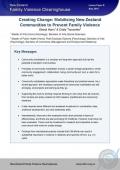 Issues Paper 8, May 2015
Issues Paper 8, May 2015
Authors: Sheryl Hann1 & Cristy Trewartha2
1 Master of Arts (Hons) (Sociology); Bachelor of Arts (Social Sciences)
2 Master of Public Health (Hons); Post Graduate Diploma (Psychology); Bachelor of Arts (Psychology); Bachelor of Commerce (Management and Employment Relations)
Downloads
Key messages
- Community mobilisation is a complex and long-term approach but has the potential to transform communities.
- Principles of community mobilisation include: a social change perspective; whole community engagement; collaboration; being community-led; and, a vision for a better world.
- Community mobilisation approaches make theoretical and practical sense. As a recent approach, the necessary components of community mobilisation are still emerging, and projects are learning as they go.
- Supporting this work to develop requires thinking in new ways from all involved, from funders and policy makers to NGO leaders, practitioners and community members.
- It also requires some different and sustained investment in coordination roles, workforce development, and new leadership skills.
- Internationally, there are a few examples which show promise in terms of effectiveness, and there are also promising NZ initiatives. However most have not been evaluated. There must be investment in research and evaluation to learn more about what works to create change.
- Findings from international projects indicate that CM efforts can result in substantial reductions in violence in relatively short periods of time, e.g. 2-3 years.
Recommended citation
Hann, S., & Trewartha, C. (2015). Creating change: Mobilising New Zealand communities to prevent family violence. Auckland, New Zealand: New Zealand Family Violence Clearinghouse, University of Auckland.
ISSN: 2253-3222, published online only.
Feedback
The Clearinghouse welcomes your feedback. Please email us - we would love to hear your comments on this issues paper.


